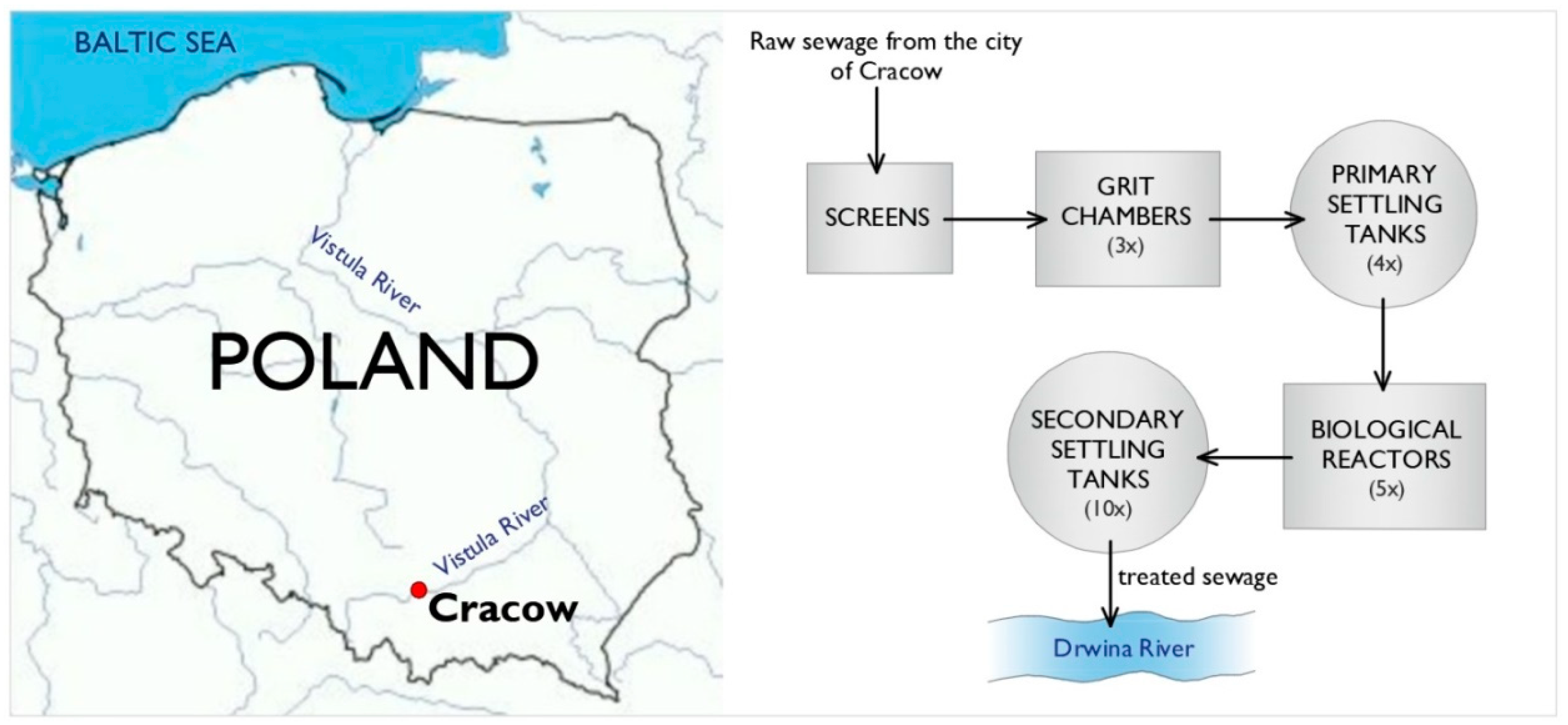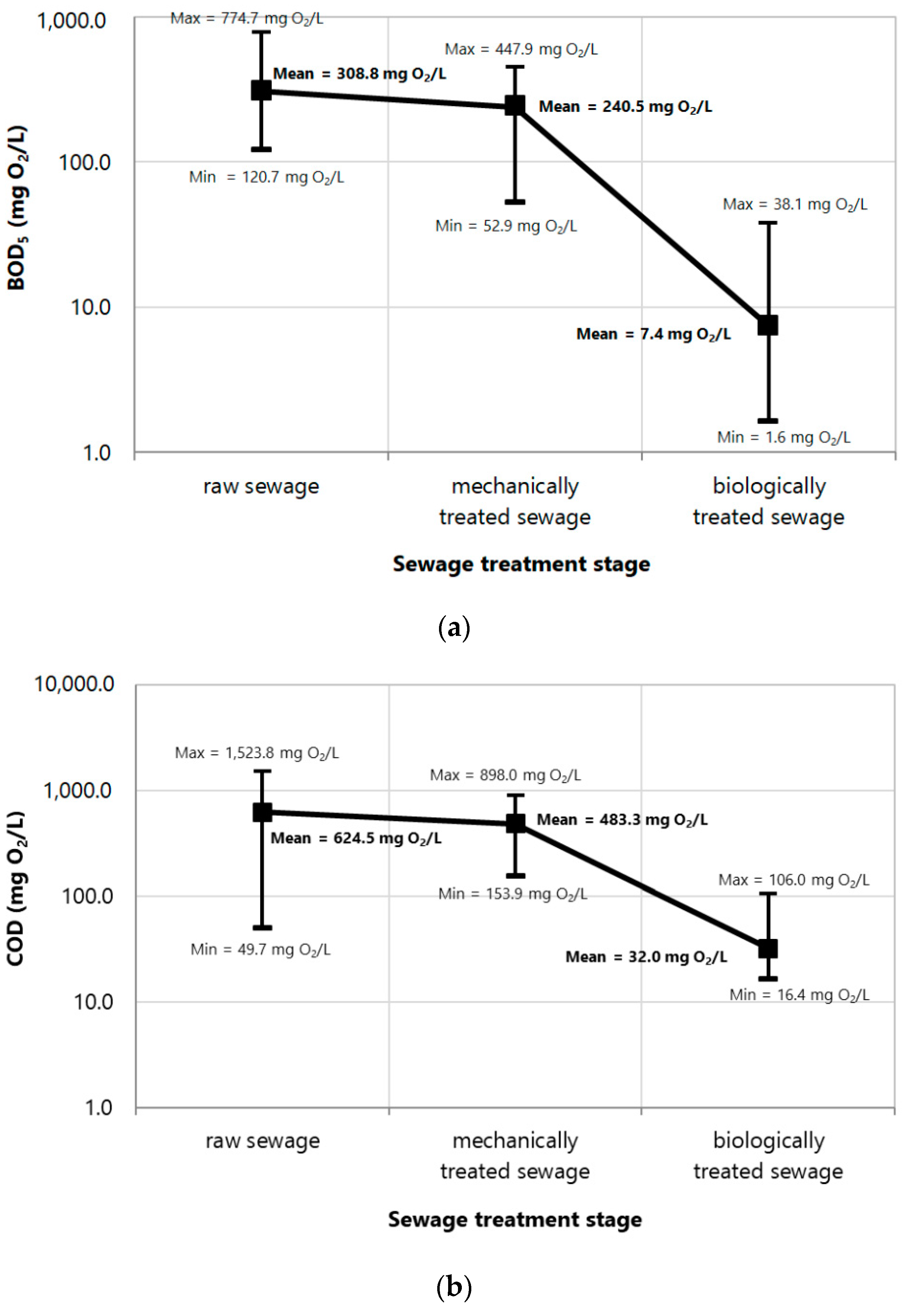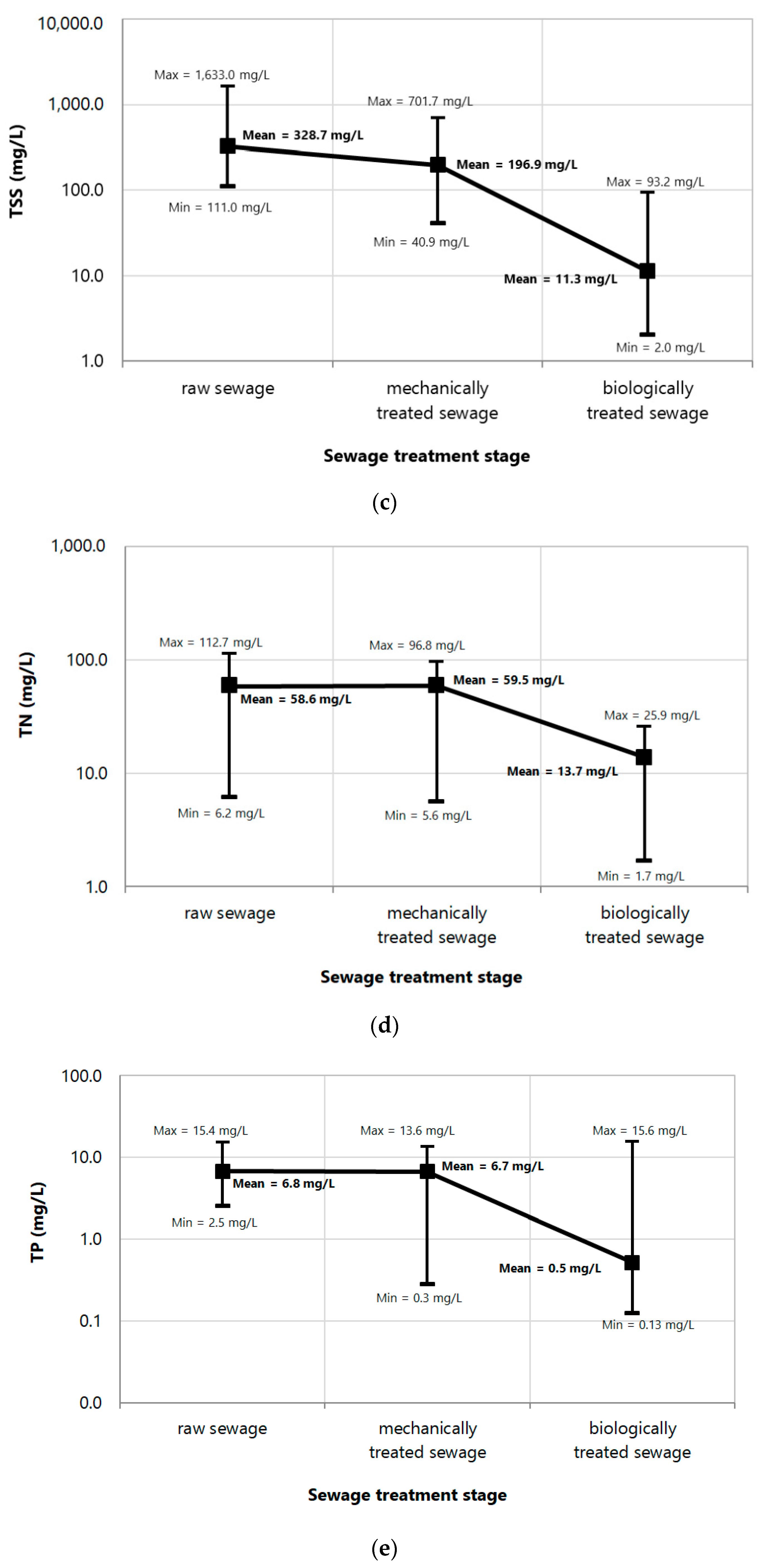Investigation of the Wastewater Treatment Plant Processes Efficiency Using Statistical Tools
Abstract
1. Introduction
2. Case Study
3. Methodology
3.1. Preliminary Statistical Data Analysis
3.2. Analysis of the Best-Fitted Theoretical Distributions
3.3. Selection of the Best-Fitted Theoretical Distributions
3.4. Modelling of the Pollutant Indicator Values
3.5. Simulation of the Sewage Quality Changes in Subsequent Treatment Stages
3.6. Simulation of Sewage Susceptibility to Biodegradability
4. Results and Discussion
4.1. Preliminary Statistical Data Analysis
4.2. Verification of the Theoretical Probability Distributions
4.3. Selection of the Best-Fitted Probability Distribution
4.4. Analysis of Expected Sewage Quality Changes after Mechanical and Biological Treatment
4.5. Assessment of Expected Sewage Susceptibility to Biodegradability
5. Summary and Conclusions
Author Contributions
Funding
Conflicts of Interest
References
- Dadrasnia, A.; Shahsavari, N.; Emenike, C.U. Wastewater treatment by biological methods. In Wastewater Engineering: Advanced Wastewater Treatment Systems; Aziz, H.A., Mojiri, A., Eds.; IJSR Publications: Penang, Malaysia, 2014; pp. 63–70. [Google Scholar]
- Collivignarelli, M.C.; Miino, M.C.; Manenti, S.; Todeschini, S.; Sperone, E.; Cavallo, G.; Abbà, A. Identification and localization of hydrodynamic anomalies in a real wastewater treatment plant by an integrated approach: RTD-CFD Analysis. Environ. Process. 2020, 7, 563–578. [Google Scholar] [CrossRef]
- Alsaqqar, A.S.; Khudair, B.H.; Al-Sulaimen, A.M. Performance evaluation of the organic matter removal efficiency in wastewater treatment plants; Case study Al- Diwaniyah WWTP in Iraq. Int. J. Sci. Res. 2017, 6, 334–338. [Google Scholar] [CrossRef]
- Al-Sulaiman, A.M.; Khudair, B.H. Correlation between BOD5 and COD for Al-Diwaniyah wastewater treatment plants to obtain the biodigrability indices. Pak. J. Biotechnol. 2018, 15, 423–427. [Google Scholar]
- Tomašić, V.; Zelić, B. Environmental Engineering: Basic Principles; Walter de Gruyter GmBH: Berlin, Germany; Boston, MA, USA, 2018. [Google Scholar]
- Srinivas, T. Environmental Biotechnology, 1st ed.; New Age International Publishers: New Delhi, India, 2008. [Google Scholar]
- Janssen, P.M.J.; Meinema, K.; van der Roest, H.F. Biological Phosphorus Removal: Manual for Design and Operation; IWA Publishing: London, UK, 2002. [Google Scholar]
- Cooper, P.; Upton, J.; Smith, M.; Churchley, J. Biological nutrient removal – retrofit solutions in the UK. Design snags, operational problems and costs. In Wastewater Treatment: Evaluation and implementation, Proceedings of Water Environment ’94, a Joint Institution of Civil Engineers and Institution of Water and Environment Management conference, London, UK, 9–10 March 1994; Thomas Thelford Services Ltd.: London, UK, 1994; pp. 170–187. [Google Scholar]
- Bugajski, P.; Pawełek, J.; Kurek, K. Concentrations of organic and biogenic pollutants in domestic wastewater after mechanical treatment in the aspect of biological reactor design. Infrastruct. Ecol. Rural Areas 2017, IV/3, 1811–1822. [Google Scholar] [CrossRef]
- Chmielowski, K.; Wąsik, E.; Operacz, A.; Bugajski, P.; Kaczor, G.; Jurík, L. Analysis of sewage susceptibility to biodegradation on an example of sewage treatment plant in Wodzisław Śląski. Infrastruct. Ecol. Rural Areas 2017, IV/1, 1427–1443. [Google Scholar] [CrossRef]
- Młyńska, A.; Chmielowski, K.; Młyński, D. The analysis of the changes in the sewage quality during treatment processes on the wastewater treatment plant in Przemyśl. Ecol. Eng. 2017, 18, 18–26. [Google Scholar] [CrossRef]
- Nowobilska-Majewska, E.; Bugajski, P. The analysis of the amount of pollutants in wastewater after mechanical treatment in the aspect of their susceptibility to biodegradation in the treatment plant in Nowy Targ. J. Ecol. Eng. 2019, 20, 135–143. [Google Scholar] [CrossRef]
- Płuciennik-Koropczuk, E.; Jakubaszek, A. Susceptibility of wastewater for biochemical decomposition in mechanical—Biological wastewater treatment processes. Sci. Pap. Environ. Eng. 2012, 148, 73–83. (In Polish) [Google Scholar]
- Abdalla, K.Z.; Hammam, G. Correlation between biochemical oxygen demand and chemical oxygen demand for various wastewater treatment plants in Egypt to obtain the biodegradability indices. Int. J. Sci. Basic Appl. Res. 2014, 13, 42–48. [Google Scholar]
- Lakhlifi, M.; Elatmani, A.; Elhammoumi, T.; Elrhaouat, O.; Sibari, M.; Elguamri, Y.; Belghyti, D.; El Kharrim, K. Prediction of biodegradability ratios in wastewater treatment plant of Skhirat Morocco. Int. J. Environ. Agric. Res. 2017, 3, 1–6. [Google Scholar]
- Bugajski, P.; Almeida, M.A.A.; Kurek, K. Reliability of sewage treatment plants processing sewage from school buildings located in non-urban areas. Infrastruct. Ecol. Rural Areas 2016, IV/3, 1547–1557. [Google Scholar] [CrossRef]
- Jóźwiakowski, K.; Bugajski, P.; Mucha, Z.; Wójcik, W.; Jucherski, A.; Nastwany, M.; Siwiec, T.; Mazur, A.; Obroślak, R.; Gajewska, M. Reliability and efficiency of pollution removal during long-term operation of a one-stage constructed wetland system with horizontal flow. Sep. Purif. Technol. 2017, 187, 60–66. [Google Scholar] [CrossRef]
- Marzec, M. Reliability of removal of selected pollutants in different technological solutions of household wastewater treatment plants. J. Water Land Develop. 2017, 35, 141–148. [Google Scholar] [CrossRef]
- Młyński, D.; Bugajski, P.; Młyńska, A. Application of the mathematical simulation methods for the assessment of the wastewater treatment plant operation work reliability. Water 2019, 11, 873. [Google Scholar] [CrossRef]
- Coronado-Hernández, Ó.E.; Merlano-Sabalza, E.; Díaz-Vergara, Z.; Coronado-Hernández, J.R. Selection of hydrological probability distributions for extreme rainfall events in the regions of Colombia. Water 2020, 12, 1397. [Google Scholar] [CrossRef]
- Fan, Y.R.; Huang, W.W.; Huang, G.H.; Li, Y.P.; Huang, K.; Li, Z. Hydrologic risk analysis in the Yangtze River basin through coupling Gaussian mixtures into copulas. Adv. Water Resour. 2016, 88, 170–185. [Google Scholar] [CrossRef]
- Sun, C.X.; Huang, G.H.; Fan, Y.; Zhou, X.; Lu, C.; Wang, X.Q. Drought occurring with hot extremes: Changes under future climate change on Loess Plateau, China. Earths Future 2019, 7, 587–604. [Google Scholar] [CrossRef]
- Oliveira, S.C.; Souki, I.; von Sperling, M. Lognormal behaviour of untreated and treated wastewater constituents. Water Sci. Technol. 2012, 65, 596–603. [Google Scholar] [CrossRef]
- Van Buren, M.A.; Watt, W.E.; Marsalek, J. Application of the log-normal and normal distributions to stormwater quality parameters. Water Res. 1997, 31, 95–104. [Google Scholar] [CrossRef]
- Wang, Y.; Ran, W. Comprehensive eutrophication assessment based on fuzzy matter element model and Monte Carlo-triangular fuzzy numbers approach. Int. J. Environ. Res. Public Health 2019, 16, 1769. [Google Scholar] [CrossRef]
- Alam, M.A.; Emura, K.; Farnham, C.; Yuan, J. Best-fit probability distributions and return periods for maximum monthly rainfall in Bangladesh. Climate 2018, 6, 9. [Google Scholar] [CrossRef]
- Glickman, T.S.; Xu, F. The distribution of the product of two random variables. Stat. Probab. Lett. 2008, 78, 2821–2826. [Google Scholar] [CrossRef]
- Wałęga, A.; Rutkowska, A.; Policht-Latawiec, A. Sensitivity of beta and Weibull synthetic unit hydrographs to input parameter changes. Pol. J. Environ. Stud. 2014, 23, 221–229. [Google Scholar]
- Wang, X. Vehicle Noise and Vibration Refinement, 1st ed.; Woodhead Publishing: Cambridge, UK, 2010. [Google Scholar]
- Yu, G.; Sapiro, G.; Mallat, S. Solving inverse problems with piecewise linear estimators: From gaussian mixture models to structured sparsity. IEEE Trans. Image Process. 2012, 21, 2481–2499. [Google Scholar] [CrossRef] [PubMed]
- Zoran, D.; Weiss, Y. From learning models of natural image patches to whole image restoration. In Proceedings of the IEEE International Conference on Computer Vision (ICCV), Barcelona, Spain, 6–13 November 2011; pp. 479–486. [Google Scholar] [CrossRef]
- Evans, D.L.; Drew, J.H.; Leemis, L.M. The distribution of the Kolmogorov–Smirnov, Cramer–von Mises, and Anderson–Darling test statistics for exponential populations with estimated parameters. In Computational Probability Applications. International Series in Operations Research & Management Science; Glen, A., Leemis, L., Eds.; Springer: Cham, Switzerland, 2017; Volume 247, pp. 165–190. [Google Scholar]
- Jäntschi, L.; Bolboacă, S.D. Computation of probability associated with Anderson–Darling statistic. Mathematics 2018, 6, 88. [Google Scholar] [CrossRef]
- Zeng, X.; Wang, D.; Wu, J. Evaluating the three methods of goodness of fit test for frequency analysis. J. Risk Anal. Crisis Response 2015, 5, 178–187. [Google Scholar] [CrossRef]
- Bezak, N.; Brilly, M.; Šraj, M. Flood frequency analyses, statistical trends and seasonality analyses of discharge data: A case study of the Litija station on the Sava River. J. Flood Risk Manag. 2016, 9, 154–168. [Google Scholar] [CrossRef]
- Regulation of the Minister of Maritime Economy and Inland Navigation of 12 July 2019 on Substances Particularly Harmful to the Aquatic Environment and Conditions to Be Met during Sewage Discharge into the Water or into the Ground and during Rainwater or Snowmelt Discharge into the Water or into the Water Devices. (In Polish). Available online: https://isap.sejm.gov.pl/isap.nsf/DocDetails.xsp?id=WDU20190001311 (accessed on 9 November 2020).
- Kaczor, G. Concentrations of the pollutants in the sewage drained from the rural sewerage systems in lesser Poland voivodship. Infrastruct. Ecol. Rural Areas 2009, 9, 97–104. (In Polish) [Google Scholar]
- Chmielowski, K.; Ślizowski, R. Evaluation of the effectiveness of pollutants’ removal in the sewage treatment plant in Tarnow. Infrastruct. Ecol. Rural Areas 2009, 5, 137–146. (In Polish) [Google Scholar]
- Kaczor, G.; Bergel, T.; Bugajski, P.; Pijanowski, J. Aspects of sewage disposal from tourist facilities in national parks and other protected areas. Pol. J. Environ. Stud. 2015, 24, 107–114. [Google Scholar] [CrossRef]
- Wąsik, E.; Chmielowski, K. Evaluation of the operation of the sewage treatment plant “Kujawy” in Cracow. Teka Kom. Ochr. Kszt. Środ. Przyr. 2013, 10, 481–488. [Google Scholar]
- Pereira, E.J.S.; Pinho, J.T.; Galhardo, M.A.B.; Macêdo, W.M. Methodology of risk analysis by Monte Carlo Method applied to power generation with renewable energy. Renew. Energy. 2014, 69, 347–355. [Google Scholar] [CrossRef]
- Stein, W.; Keblis, M. A new method to simulate the triangular distribution. Math. Comput. Model. 2009, 49, 1143–1147. [Google Scholar] [CrossRef]
- Bouzenad, K.; Ramdani, R. Multivariate statistical process control using enhanced bottleneck neural network. Algorithms 2017, 10, 49. [Google Scholar] [CrossRef]
- Yu, J. A nonlinear kernel Gaussian mixture model based inferential monitoring approach for fault detection and diagnosis of chemical processes. Chem. Eng. Sci. 2012, 68, 506–519. [Google Scholar] [CrossRef]
- Henze, M.; van Loosdrecht, M.C.M.; Ekama, G.A.; Brdjanovic, D. Biological Wastewater Treatment: Principles, Modelling and Design; IWA Publishing: London, UK, 2008. [Google Scholar]









| Pollutant Indicator | Min (mg/L) | Mean (mg/L) | Max (mg/L) | S (mg/L) | Cs (–) |
|---|---|---|---|---|---|
| Raw sewage | |||||
| BOD5 | 110.0 | 309.1 | 700.0 | 121.1 | 0.4 |
| COD | 225.0 | 627.9 | 1,260.0 | 241.5 | 0.4 |
| TSS | 110.0 | 339.1 | 1,200.0 | 218.3 | 0.6 |
| TN | 25.7 | 58.1 | 90.0 | 14.3 | 0.2 |
| TP | 2.3 | 6.7 | 13.2 | 2.4 | 0.4 |
| Mechanically treated sewage | |||||
| BOD5 | 105.0 | 241.3 | 380.0 | 67.6 | 0.3 |
| COD | 213.0 | 484.6 | 750.0 | 135.9 | 0.3 |
| TSS | 40.0 | 192.1 | 420.0 | 91.2 | 0.5 |
| TN | 26.0 | 59.7 | 85.3 | 14.0 | 0.2 |
| TP | 2.7 | 6.8 | 11.9 | 1.7 | 0.3 |
| Biologically treated sewage | |||||
| BOD5 | 1.9 | 7.7 | 31.0 | 6.1 | 0.8 |
| COD | 14.8 | 34.0 | 171.0 | 23.7 | 0.7 |
| TSS | 2.0 | 9.6 | 96.0 | 15.8 | 1.6 |
| TN | 4.6 | 13.7 | 22.7 | 4.3 | 0.3 |
| TP | 0.1 | 0.5 | 3.3 | 0.6 | 1.3 |
| Distribution | BOD5 | COD | TSS | TN | TP | |||||
|---|---|---|---|---|---|---|---|---|---|---|
| A-D | p | A-D | p | A-D | p | A-D | p | A-D | p | |
| Raw sewage | ||||||||||
| GEV | 0.62 | 0.63 | 0.35 | 0.90 | 0.39 | 0.86 | 0.52 | 0.73 | 0.46 | 0.79 |
| Log-normal | 0.68 | 0.57 | 0.47 | 0.78 | 0.83 | 0.46 | 0.86 | 0.44 | 0.49 | 0.76 |
| GMM | 0.70 | 0.56 | 0.25 | 0.97 | 0.43 | 0.82 | 0.24 | 0.98 | 0.34 | 0.91 |
| Normal | 1.67 | 0.14 | 1.60 | 0.15 | 3.36 | 0.02 | 0.47 | 0.78 | 1.35 | 0.22 |
| Weibull | 1.50 | 0.18 | 1.36 | 0.21 | 2.07 | 0.09 | 0.61 | 0.63 | 1.25 | 0.25 |
| Triangular | 3.71 | 0.01 | 2.78 | 0.04 | 16.19 | 0.00 | 2.49 | 0.05 | 4.40 | 0.01 |
| Mechanically treated sewage | ||||||||||
| GEV | 0.37 | 0.88 | 0.29 | 0.94 | 0.87 | 0.43 | 0.21 | 0.99 | 0.51 | 0.73 |
| Log-normal | 1.22 | 0.26 | 1.03 | 0.34 | 0.99 | 0.36 | 1.48 | 0.18 | 0.76 | 0.51 |
| GMM | 0.26 | 0.96 | 0.21 | 0.99 | 0.41 | 0.84 | 0.13 | 1.00 | 0.16 | 1.00 |
| Normal | 0.40 | 0.85 | 0.34 | 0.91 | 1.96 | 0.10 | 0.42 | 0.83 | 0.47 | 0.78 |
| Weibull | 0.36 | 0.89 | 0.31 | 0.93 | 1.37 | 0.21 | 0.24 | 0.97 | 0.70 | 0.56 |
| Triangular | 2.81 | 0.03 | 3.01 | 0.03 | 3.29 | 0.02 | 2.32 | 0.06 | 2.42 | 0.06 |
| Biologically treated sewage | ||||||||||
| GEV | 0.86 | 0.44 | 1.05 | 0.33 | 0.41 | 0.84 | 0.19 | 0.99 | 0.18 | 0.99 |
| Log-normal | 1.13 | 0.30 | 2.47 | 0.05 | 1.73 | 0.13 | 0.55 | 0.70 | 1.86 | 0.11 |
| GMM | 0.48 | 0.77 | 1.14 | 0.29 | 0.72 | 0.54 | 0.17 | 0.98 | 0.99 | 0.36 |
| Normal | 4.98 | 0.00 | 6.73 | 0.00 | 8.62 | 0.00 | 0.19 | 0.99 | 6.52 | 0.00 |
| Weibull | 2.65 | 0.04 | 5.32 | 0.00 | 3.74 | 0.01 | 0.20 | 0.99 | 3.12 | 0.02 |
| Triangular | 12.90 | 0.00 | 35.61 | 0.00 | 56.24 | 0.00 | 2.29 | 0.06 | 42.02 | 0.00 |
| Pollutant Indicator | GEV | Log-Normal | GMM | Normal | Weibull | Triangular |
|---|---|---|---|---|---|---|
| Raw sewage | ||||||
| BOD5 | 122.90 | 126.41 | 136.54 | 148.48 | 144.17 | – |
| COD | 150.79 | 149.70 | 142.79 | 171.08 | 166.35 | – |
| TSS | 139.15 | 162.77 | 141.01 | – | 170.38 | – |
| TN | 40.84 | 51.60 | 33.35 | 37.16 | 41.02 | 46.64 |
| TP | −27.91 | −30.63 | −44.38 | −8.58 | −11.09 | – |
| Mechanically treated sewage | ||||||
| BOD5 | 92.52 | 120.59 | 83.64 | 91.29 | 89.72 | – |
| COD | 115.60 | 146.63 | 102.97 | 115.95 | 113.24 | – |
| TSS | 122.34 | 125.06 | 113.23 | 125.76 | – | – |
| TN | 26.70 | 68.56 | 16.79 | 39.13 | 31.86 | 43.00 |
| TP | −39.25 | −37.82 | −57.33 | −40.26 | −33.61 | −22.97 |
| Biologically treated sewage | ||||||
| BOD5 | 32.71 | 37.75 | −1.38 | – | – | – |
| COD | 105.55 | 108.53 | 104.51 | – | – | – |
| TSS | 72.49 | 93.07 | 81.63 | – | – | – |
| TN | −26.85 | 8.08 | −28.56 | −28.92 | −28.04 | −0.17 |
| TP | −11.91 | −44.33 | −56.04 | – | – | – |
| Pollutant Indicator | After Mechanical Treatment | After Mechanical and Biological Treatment |
|---|---|---|
| BOD5 | 22.1% | 97.6% |
| COD | 22.6% | 94.9% |
| TSS | 40.1% | 96.6% |
| TN | – | 76.6% |
| TP | 1.0% | 92.4% |
Publisher’s Note: MDPI stays neutral with regard to jurisdictional claims in published maps and institutional affiliations. |
© 2020 by the authors. Licensee MDPI, Basel, Switzerland. This article is an open access article distributed under the terms and conditions of the Creative Commons Attribution (CC BY) license (http://creativecommons.org/licenses/by/4.0/).
Share and Cite
Młyński, D.; Młyńska, A.; Chmielowski, K.; Pawełek, J. Investigation of the Wastewater Treatment Plant Processes Efficiency Using Statistical Tools. Sustainability 2020, 12, 10522. https://doi.org/10.3390/su122410522
Młyński D, Młyńska A, Chmielowski K, Pawełek J. Investigation of the Wastewater Treatment Plant Processes Efficiency Using Statistical Tools. Sustainability. 2020; 12(24):10522. https://doi.org/10.3390/su122410522
Chicago/Turabian StyleMłyński, Dariusz, Anna Młyńska, Krzysztof Chmielowski, and Jan Pawełek. 2020. "Investigation of the Wastewater Treatment Plant Processes Efficiency Using Statistical Tools" Sustainability 12, no. 24: 10522. https://doi.org/10.3390/su122410522
APA StyleMłyński, D., Młyńska, A., Chmielowski, K., & Pawełek, J. (2020). Investigation of the Wastewater Treatment Plant Processes Efficiency Using Statistical Tools. Sustainability, 12(24), 10522. https://doi.org/10.3390/su122410522






